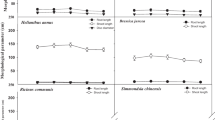Abstract
A field study was conducted to investigate the efficiency of Zn phytoextraction by Nicotiana tabacum and Zea mays from a soil that had been artificially contaminated by different amounts of ZnSO4 (0, 50, 150, 350, 750 and 1550 mg kg−1 soil) 10 years prior to the present cropping.
Increased NaNO3-extractable Zn in soil translated well into shoot concentrations (dry matter) in plants. Zn uptake by Z. mays increased linearly with increasing NaNO3-extractable Zn in soil, while for N. tabacum the increase could be described by a Langmuir isotherm. While Z. mays showed no significant decrease in biomass production up to the highest contamination level in soil, N. tabacum responded with a reduction of plant growth of about 50% compared with control plants at the highest Zn concentrations in soil. Maximum removal of Zn was 13 kg ha−1 y−1 with Z. mays and 11 kg ha−1 y−1 with N. tabacum. Calculated time required to reduce soil Zn from 350 to 150 mg kg−1 was about 55 years for N. tabacum and about 63 years for Z. mays at a soil pH of 4.8. At higher soil pH of 6.0 calculated decontamination time was about 87 years for N. tabacum and more than 200 years for Z. mays.
Only small amounts of Zn were translocated into the seeds of N. tabacum and cobs of Z. mays. Therefore, corn cobs of Z. mays could be safely used for fodder and the seeds of N. tabacum, which are rich in oil, for industrial purposes, e.g. in the paint industry.
Similar content being viewed by others
References
Chaney R L 1993 Zinc phytotoxicity. In Zinc in Soils and Plants. Ed. A D Robson. pp 135–150. Kluwer Academic Publishers, Dordrecht, the Netherlands.
Cunningham S C, Berti W R and Huang J W 1995 Phytoremediation of contaminated soils. TIBTECH 13, 393–397.
Ebbs S D, Lasat M M, Brady D J, Cornish J, Gordon R and Kochian L V 1997 Phytoextraction of cadmium and zinc from a contaminated soil. J. Environ. Qual. 26, 1424–1430.
Ebbs S D and Kochian L V 1998 Phytoextraction of zinc by oat (Avena sativa), barley (Hordeum vulgare), and Indian mustard (Brassica juncea). Environ. Sci. Technol. 32(6), 802–806.
Edenspace 2000 http://www.phytotech.com:80/CaseStudies.htm.
EPA 2000 Brownfields Success Stories: Mustard helping to clean up site. http://www.epa.gov/swerosps/bf/html-doc/ss-trnt1.htm.
El-Hamid M F A, El-Naggar H A, El-Sakr A S and Abdel-Hamid MF 1982 Chemical studies on tobacco seed oils from some varieties cultivated in Egypt. Research Bulletin, Fac. Agric., Aiin Shams Univ. No. 1737.
FAL, RAC, FAW 1996 Schweizerische Referenzmethoden der Eidgenössischen landwirtschaftlichen Forschungsanstalten, Band 1–4.
Felix H R 1997 Field trials for in situ decontamination of heavy metal polluted soils using crops of metal-accumulating plants. Z. Pflanzenernähr. Bodenk. 160, 525–529.
FMBV 1995 Futtermittel: Futtermittelverordnung und Futtermittelbuch-Verordnung mit Anhängen. SR 916.307/916.307.1. Schweizerischer Bundesrat und Eigenössisches Volkswirtschaftsdepartement, Bern.
Gupta S K 1989 Metallverteilung zwischen fester und löslicher Phase des Bodens und ihre Bedeutung zur Beurteilung ökologischer Probleme. BGS-Bulletin 13, 69–74.
Gupta S K and Aten C 1993 Comparison and evaluation of extraction media and their suitability in a simple model to predict the biological relevance of heavy metal concentrations in contaminated soils. Intern. J. Environ. Anal. Chem. 51, 25–46.
Hornburg V and Brümmer G W 1993 Verhalten von Schwermetallen in Böden. 1. Untersuchungen zur Schwermetallmobilität. Z. Pflanzenern. Bodenk. 156, 467–477.
Jørgensen S E 1993 Removal of heavy metals from compost and soil by ecotechnological methods. Ecol. Eng. 2, 89–100.
Kayser A, Wenger K, Keller A, Attinger W, Felix H R, Gupta S K and Schulin R 2000 Enhancement of phytoextraction of Zn, Cd and Cu from calcareous soil: the use of NTA and sulphur amendments. Environ. Sci. Technol.
Kayser A 2000 Evaluation and enhancement of phytoextraction of heavy metals from contaminated soils. Thesis. ETH Zürich, Zürich.
Kumar P B A N, Dushenkov V, Motto H and Raskin I 1995 Phytoextraction: the use of plants to remove heavy metals from soils. Environ. Sci. Technol. 29(5), 1232–1238.
Marschner H 1995 Mineral Nutrition of Higher Plants. Academic Press Limited, London. 809 p.
McGrath S P, Sidoli C M D, Baker A J M and Reeves R D 1993 The potential for the use of metal-accumulating plants for the in situ decontamination of metal-polluted soils. In Integrated Soil and Sediment Research: A Basis for Proper Protection. Eds. H J P Eijsackers and T Hamers. pp 673–676. Kluwer Academic Publishers, Dordrecht, the Netherlands.
McGrath S P 1998 Phytoextraction for soil remediation. In Plants that Hyperaccumulate Heavy Metals: Their Role in Phytoremediation, Microbiology, Archaeology, Mineral Exploration and Phytomining. Ed. R R Brooks. pp 261–287. CAB International, Wallingford, Oxon, UK, New York.
Mench M, Tancogne J, Gomez A and Juste C 1989 Cadmium bioavailability to Nicotiana tabacum L., Nicotiana rustica L., and Zea mays L. grown in soil amended or not amended with cadmium nitrate. Biol. Fertil. Soils 8, 48–53.
Robinson B H, Leblanc M, Petit D, Brooks R R, Kirkman J H and Gregg P E H 1998 The potential of Thlaspi caerulescens for phytoremediation of contaminated soils. Plant and Soil 203, 47–56.
Schmid T and Wegelin T 1996 Wachstumsstörungen bei Kulturpflanzen durch Schwermetallbelastungen im Boden. FaBo Kanton Zürich.
12html. 01.07.1998.
Walther U, Menzi H, Ryser J-P, Flisch R, Jeangros G, Kessler W, Maillard A, Siegenthaler A F and Vuilloud P A 1994 Grundlagen für die Düngung im Acker-und Futterbau. Agrarforschung 1(7), 1–40.
Wilcke B M and Metz R 1993 Einsatz von Engergiepflanzen zur Dekontamination schwermetallbelasteter Böden. Ecoinforma 2, 199–210.
Author information
Authors and Affiliations
Corresponding author
Rights and permissions
About this article
Cite this article
Wenger, K., Gupta, S.K., Furrer, G. et al. Zinc Extraction potential of two common crop plants, Nicotiana tabacum and Zea mays . Plant and Soil 242, 217–225 (2002). https://doi.org/10.1023/A:1016253821174
Issue Date:
DOI: https://doi.org/10.1023/A:1016253821174




